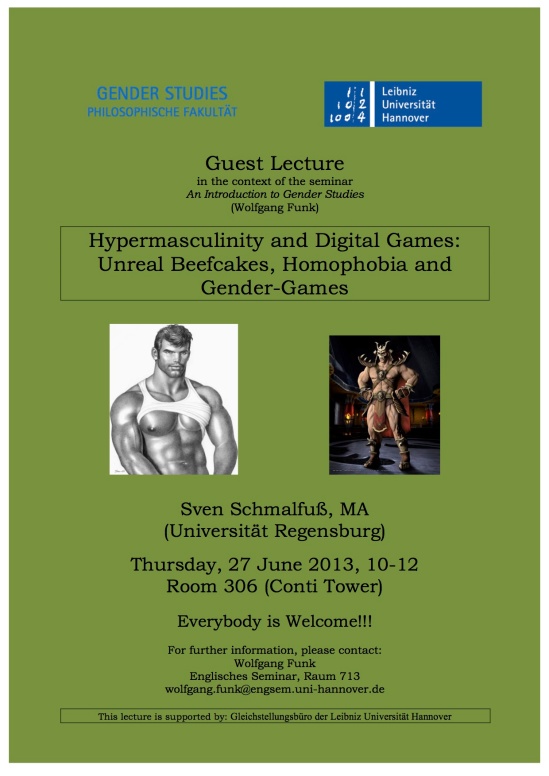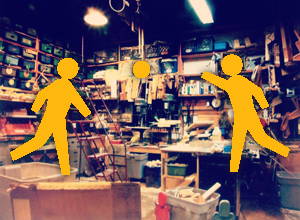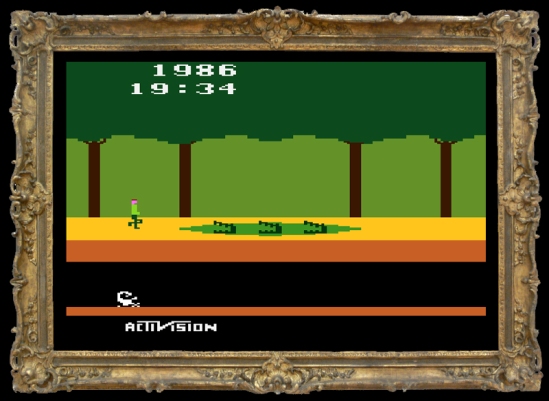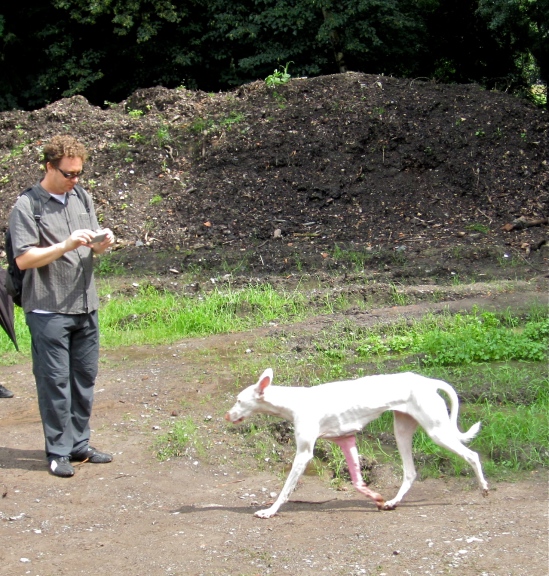On Thursday, June 27, 2013 (10:00-12:00, room 306 in the Conti-Hochhaus), the English Department and the Gender Studies program of the Faculty of Humanities will be hosting a guest lecture by Sven Schmalfuß of the University of Regensburg. The lecture, titled “Hypermasculinity and Digital Games: Unreal Beefcakes, Homophobia and Gender-Games,” is free and open to all. For more information, please contact Wolfgang Funk.
Tag: game studies
Batman and the “Parergodic” Work of Seriality in Interactive Digital Environments
On Saturday, December 15 (11:30 am, 6th floor of the Conti-Hochhaus, room TBA) — in the context of a research colloquium of the American studies department — I will be presenting some work in progress from my “Habilitation” project Figuring Serial Trajectories (more info about my project here; also, more info about the larger collaborative project with Ruth Mayer on serial figures here, and the website of the overarching research group on popular seriality here).
The topic of my talk will be Batman, computer games, and digital media environments. I will be expanding on, and trying to make somewhat more concrete, the idea of “parergodicity” which I presented at the recent FLOW conference (see here for my position paper).
Here is the abstract for my talk:
Batman and the “Parergodic” Work of Seriality in Interactive Digital Environments
Shane Denson
In the twentieth century, serial figures like Tarzan, Frankenstein’s monster, and Sherlock Holmes enacted a broadly “parergonal” logic; that is, in their plurimedial instantiations (in print, film, radio, TV, etc.), they continually crossed the boundaries marked by these specific media, slipped in and out of their frames, and showed them – in accordance with the logic of the parergon as described by Jacques Derrida – to be reversible. Through such oscillations, serial figures were able to transcend the particularity of any single iteration, and more importantly they were able to constitute themselves as higher-order frames or media, within which the transformations of first-order (i.e. apparatically concrete) media could be traced in the manner of an ongoing – though not altogether linear – series.
In the twenty-first century, many classic serial figures have declined in popularity, while the basic functions and medial logics of those that remain have been transformed in conjunction with the rise of interactive, networked, and convergent digital media environments. As I will argue in this presentation, the figure of Batman exemplifies this shift as the transition from a broadly “parergonal” to a specifically “parergodic” logic; the latter term builds upon Espen Aarseth’s notion of the “ergodic” situation of gameplay – where ergodics combines the Greek ergon (work) and hodos (path), thus positing nontrivial labor as the aesthetic mode of players’ engagement with games. Expanded beyond narrowly ludological frames of reference to include a wider variety of interactive and participatory potentials in contemporary culture, ergodic media give rise to new forms of seriality that accompany, probe, and trace the developmental trajectories of the new media environment. These new forms and functions of seriality, as embodied by a figure like Batman, raise questions about the blurring of relations between work and play, between paid labor and the incidental work or “immaterial labor” culled from our leisure activities and entertainment practices, in the age of the “control society” (Deleuze) or of “post-cinematic affect” (Shaviro). Following Batman’s transitions from comics to graphic novels, to the films of Tim Burton and Christopher Nolan, and on to the popular and critically acclaimed videogames Arkham Asylum and Arkham City, I will demonstrate that the dynamics of border-crossing which characterized earlier serial figures has now been re-functionalized in accordance with the ergodic work of navigating computational networks – in accordance, that is, with work and network forms that frame all aspects of contemporary life.
Extending Play: Rutgers Media Studies Conference
Thanks to Aaron Trammell, who was scheduled to be on the “Game Studies as Media Studies” roundtable with me at the FLOW 2012 Conference, but who was unable to make it due to Hurricane Sandy, I have just learned of an exciting conference going on April 19-20, 2013 at Rutgers University (Aaron is on the organizing committee). The conference is entitled “Extending Play,” and it’s not too late to submit a proposal (but hurry, the deadline is December 1!). Here’s the CFP:
Can we still define play as an organizing principle in today’s technologically mediated world?
Play can be hard work and serious business, and it’s time to push beyond the conceptualization of play as merely the pursuit of leisure and consider how the issues of power, affect, labor, identity, and privacy surround the idea and practice of play. The Rutgers Media Studies Conference: Extending Play invites submissions that seek to understand play as a mediating practice, and how play operates at the center of all media.
We are interested in all approaches to the traditions, roles, and contexts of play, and hope to explore how play can be broadly defined and incorporated as a fundamental principle extending into far-flung and unexpected arenas. Johan Huizinga characterizes man as the species that plays: “Law and order, commerce and profit, craft and art, poetry, wisdom and science. All are rooted in the primaeval soil of play” (Homo Ludens, p.5). How does play operate as a civilizing function — or is it perhaps a technology that produces order?
Play is a means of exploring and joining various disciplines: Social media, mash-ups, and blogs have altered how we communicate and create; game design has influenced how businesses relate to consumers; citizen journalists have shifted the role of the professional in mediating information and forging a public sphere.
To explore these questions, we invite scholars, students, tinkerers, visionaries, and players to the first ever Rutgers Media Studies Conference: Extending Play, to be held April 19th and 20th, 2013 on the Rutgers University campus in New Brunswick, NJ. Confirmed speakers for our keynote conversations include Fred Turner (Stanford University) & Stephen Duncombe (New York University) and Trevor Pinch (Cornell University) & Paul D. Miller, aka DJ Spooky (The European Graduate School).
We invite individuals from media studies and related fields in the humanities and social sciences to participate. Potential topics for paper, panel, roundtable, and workshop may include, but are not limited to:
-Playing with labor: work-like games and game-like work
-Play as resistance (culture jamming, situationist art, or other contexts)
-Gendering (and gendered) play
-Music and performance
-Linguistic play
-Play and social media
-Playing with identity
-Love and play (flirtation, AI relationships, robotica, etc)
-Gamification and games in nontraditional settings
-Transgression, cheating, and “gaming” systems
-Darker side of play (trolling, gambling, or corruption)
-Game studiesThe Rutgers Media Studies Conference: Extending Play promises to offer a memorable meeting of scholarship, and to that end, we are looking to play with standard conference conventions. One track throughout the conference will be a series of public workshop sessions in which scholars and practitioners will host roundtable discussions on contemporary issues that bring together an audience of experts and interested parties. In the academic panel track, each presenter will have a maximum of 15 minutes to offer his or her ideas as a presentation or interactive conversation, and will choose one of the following methods of presentation:
–material accompaniment (hand out a zine, scrapbook, postcard series, etc)
–performance (spoken word, song, verse, dance, recording, etc)
–limited visuals (a maximum of 3 slides and 25 total words)
–game (create rules and incorporate audience play)
For additional ideas on how to play with media, play with time, or play with space during your presentation, visit our Style Guide.The deadline for proposals is Saturday, December 1, 2012. We invite individual proposals, full panel proposals (of four members), and proposals for roundtable and workshop sessions. Please email an abstract of approximately 247 words, along with your name, affiliation, presentation method, and a short biography to mediacon@rutgers.edu. If you are interested in proposing a topic for our public workshop track, or are interested in participating in one, please indicate that as well. Notifications of acceptance will be sent out by mid-January 2013.
For more info, see the conference website: mediacon.rutgers.edu
Ludic Serialities and the “Parergodicity” of Game Studies as Media Studies — #Flow12
Here’s my position paper for the “Game Studies as Media Studies” panel at the FLOW Conference 2012 in Austin, Texas (November 1-3).
Ludic Serialities and the “Parergodicity” of Game Studies as Media Studies
Shane Denson, Leibniz Universität Hannover
The topic of this panel, “Game Studies as Media Studies,” challenges us to stipulate relations (however tentatively) between two fields of study that are themselves in many ways intersectional, cross-disciplinary, and thus to a certain extent undefined. Indeed, by broaching this topic we are returned to the (self-proclaimed) inaugural moment of game studies: to the debates raging as Espen Aarseth famously announced, in 2001’s premiere issue of the online journal Game Studies, “Year One” of computer game studies. In his attempt to stake out the terrain for “a new discipline” and protect it from “colonising efforts” from film and literary studies, Aarseth declared games’ independence from “old mass media, such as theatre, movies, TV shows and novels.” Already eleven years ago, then, Aarseth rejected the idea of game studies as media studies, writing: “Some would argue that the obvious place for game studies is in a media department, but given the strong focus there on mass media and the visual aesthetics, the fundamentally unique aspects of the games could easily be lost.”
The background, of course, was the so-called narratology-versus-ludology debate. And though that debate has since subsided (to the point, even, that some question whether it ever took place at all; cf. Frasca 2003), many of the central points of contention inevitably arise again when we undertake to reassess the relations between game studies and media studies. The crux, of course, is the ludological idea that the defining feature of games as a medium, and hence the core concern of game studies, is the interactive or, in Aarseth’s (1997) term, “ergodic” situation of gameplay – where ergodics combines the Greek ergon (work) and hodos (path), thus positing nontrivial labor as the aesthetic mode of players’ engagement with games. From a ludological perspective, narrative then appears as marginal, subordinate, or at best supplementary or parallel to gameplay – hence para- or “parergodic,” as I propose calling it. And not just narrative, but many of the aspects that might interest media scholars occupy this marginal or framing field of parergodics: from visual forms on screen, for example, to the social and cultural formations they give rise to in the wider world, outside the games themselves.
But parergodicity, a term which combines Aarseth’s “ergodics” with Derrida’s (1987) “parergon,” is not clearly distinguishable from the core of ergodics; on the contrary, the parergodic enacts a logic of supplementarity, a multistable oscillation such as Derrida ascribes to the picture frame: standing outside the work and serving as its background, the frame can also shift and become part of the figure when seen against the background of the wall. Parergodicity, I propose, defines a broad space for media studies research on games, allowing us more generally to rethink the relations between media studies and game studies so as to avoid both extremes of incommensurability and of colonization: “game studies as media studies,” conceived as a field of parergodic inquiry, aims at once to acknowledge the medial specificity of games, their resistance to paradigms established by studying dominant media like film and TV, without thereby ignoring the many empirical and conceptual points of contact that exist.
A key field of parergodic phenomena that demonstrates this potential is the widespread but undertheorized seriality that characterizes games at virtually every level of their material, cultural, and intermedial expression. While the serialization practices that generate ever new iterations of Mario, Zelda, or Lara Croft might seem to be clearly extraneous to the ergodic activity of gameplay, this is far from obvious. In the context of a joint project entitled “Digital Seriality: The Serial Aesthetics and Practice of Digital Games,” Andreas Jahn-Sudmann and I have identified three levels across which seriality can be seen to resonate. Most basically, seriality informs gameplay directly through formal-algorithmic structures of repetition/variation and the intra-ludic seriality of progressive game “levels” (which often repeat, and vary, the basic representational but also actional structures established in earlier levels, thus establishing both episodic closure and continuation). Sequels, remakes, and other explicit serialization practices constitute inter-ludic serialities that are operative between games, but not without consequence or relation to gameplay proper and its infrastructure (the modularity of game engines promotes inter-ludic serialization, for example, essentially repeating the serial patterning of intra-game levels). Moreover, fan practices and transmedial phenomena beyond the games themselves instantiate extra- or para-ludic serialities, which tie gameplay into larger networks of media consumption and exchange. As parergodic phenomena, ludic serialities therefore cut across the divisions that were taken to separate narratological and ludological positions. Finally, then, these serial structures offer both a broad basis for cross-media comparisons (from dime novels, film serials, TV series, etc.), as well as the means for identifying salient differences of digital interactivity, thus articulating a field of parergodics as the site of overlap, complementarity, and mutual advantage for game studies and media studies.
Works cited:
Aarseth, Espen J. 1997. Cybertext: Perspectives on Ergodic Literature. Baltimore: Johns Hopkins UP.
Aarseth, Espen J. 2001. “Computer Game Studies, Year One.” Game Studies 1.1 (July 2001): <http://www.gamestudies.org/0101/editorial.html>.
Derrida, Jacques. 1987. The Truth in Painting. Trans. Geoff Bennington and Ian McLeod. Chicago: U of Chicago P.
Frasca, Gonzalo. 2003. “Ludologists love stories, too: Notes from a debate that never took place.” Level Up Conference Proceedings. Utrecht: University of Utrecht. 92-99. <http://www.digra.org/dl/db/05163.01125>.
Ludic Serialities @FlowConf2012 #Flow12
I am pleased to learn that my proposal has been accepted in a panel on “Game Studies as Media Studies” at this year’s FLOW Conference in Austin, Texas (organized biannually by graduate students in the Department of Radio-Television-Film at UT). Interestingly, no papers will be presented at the conference — just five-minute statements followed by panel discussions. The preliminary schedule is now up at the conference website, and for the most part it looks great (though I do regret to see that my panel is scheduled to run concurrently with the panel on “Teaching TV” — I was looking forward to seeing Jason Mittell there, who left Germany a few months ago after his year-long stay in Göttingen; I guess we’ll just have to get a beer afterwards…). Anyway, my proposal is based on a project that I’m currently developing with Andreas Jahn-Sudmann (on “Digital Seriality: The Serial Aesthetics and Practice of Digital Games”). Here’s my short abstract:
Ludic Serialities
Shane Denson
In order to think through the affordances and consequences of conceiving game studies as part of humanities-oriented media studies – as opposed both to non-disciplinary approaches to games as focal objects for many disciplines, as well as to strong disciplinary programs following from “ludological” assertions of digital games’ medial exceptionality – I propose looking at a widespread but undertheorized aspect of video games: viz. the seriality that characterizes games at virtually every level of their material, cultural, and intermedial expression. Seriality informs gameplay through formal-algorithmic structures of repetition/variation and the intra-ludic seriality of progressive game “levels”; sequels, remakes, and other explicit serialization practices constitute inter-ludic serialities; finally, fan practices and transmedial phenomena beyond the games themselves instantiate extra-ludic serialities. Careful attention to serial structures offers both a broad basis for cross-media comparisons (from dime novels, film serials, TV series, etc.), as well as the means for identifying salient differences of digital interactivity.
Mediate. Discorrelate. Recalibrate.
Besides giving lectures and workshops, Mark Hansen has been taking his visit here as an opportunity to see a good deal of art. Last week I accompanied him to the documenta in Kassel, which is really excellent this time around. Lots of opportunities to aesthetically discorrelate and recalibrate — which happens to have been the subject of my “response” (partly synoptic, partly associative, and certainly highly inconclusive) to an article called “Ubiquitous Sensation” that we discussed at the workshop last Friday. Here are the notes I was working with:
Mediate. Discorrelate. Recalibrate. Or: How to Enjoy Impersonal Sensation. Or Yet Again: Having the Time of Your Life and Then Some.
A Response to Mark B. N. Hansen.
Shane Denson, Hannover, 6 July 2012
Mark Hansen’s “Ubiquitous Sensation or the Autonomy of the Peripheral” (forthcoming in Ulrik Ekman’s edited volume, Throughout: Art and Culture Emerging with Ubiquitous Computing) seeks to make sense of the sensory impacts occasioned by computational technologies operating on microtemporal scales – and thus outside the scales proper to subjective perception. Ubiquitous computing, or ubicomp, materially articulates this question, as it is by design “invisible” – which is to say, phenomenally and physically removed from the field of our perceptual attention. And yet, as Hansen shows by way of an exploratory engagement with several artworks, such technologies continue to exert an influence from a position that is radically and resolutely peripheral to perception. Against the claims of early ubicomp visionaries, who imagined this peripherality and invisibility as always ultimately serving the centered (perceptual) subjectivity of deliberate human action, Hansen maintains that because the microtemporal operations enacted by these technologies are categorically beyond or below the threshold of our perception, ubicomp must be seen as instantiating a level of material autonomy, the “autonomy of the peripheral,” that requires us to rethink media and their relation to human experience.
At stake, then, on one level, is a new conception of media, one that breaks with a long-standing tendency to correlate media with human sensory ratios, and to see media as vehicles for storing and reproducing human perceptual experience. Centrally, this tendency is related to Western thought’s privileging of the visual register, which itself can be seen as an exemplary means of constituting media as objects, locating them squarely in the purview of our subjective gazes, and thereby neutralizing any fundamental transformative potential that they might have if accorded autonomy from our perceptual control. It might be helpful here to recall Bruno Latour’s distinction between “intermediaries” and “mediators.” Intermediaries serve as channels that more or less transparently relay information or experiential content from point A to point B. Assuming that those points are people, or subjects, media as intermediaries offer perceptual objects that, because their contents are isomorphic with the contents of natural perception, can circulate in such a way as to expand the power (and life-span or historical longevity) of visual or other perceptual experience without thereby challenging or undermining the foundational stability and centrality of the subject. Mediators, on the other hand, are radically transformative; unlike intermediaries, they are not objects that pass neutrally between subjects but are instead what Latour calls hybrid “quasi-objects,” which articulate the very distinctions and relations obtaining between subjects and objects. By asserting the autonomy of the peripheral, by disconnecting ubicomp and related technologies from the narrow bandwidth of subjectively defined instrumentality, and more generally by discorrelating media from human perception, Hansen similarly breaks with the view of media as intermediaries, and – by positioning media as environmental factors – he shows them to be like Latour’s mediators in their ability to impact us materially, impersonally, and prior to the articulation of subjectivity.
This only works, though, if the discorrelation of media from perception does not imply their complete removal from the domain of sensation. In other words, sensation itself must be seen as occurring outside of perceptual subjectivity, and this impersonal sensation will be the site of our primary, pre-personal interaction with technics. Through discorrelation, in other words, the impact of media is not at all diminished; on the contrary, its directness in fact becomes apparent for the first time. Moreover, perceptually discorrelated media do not remain disconnected but operate precisely by effecting various means and forms of recalibration. Thus, the central experiential impact of invisible computing is constituted by its capacity to recalibrate our microsensory (and thus sub-personal, unconscious) capacities with an environment transformed by the introduction of technologies operating on microtemporal scales – and indeed embodying, operationally, microsensations of their own. In comparison to Hansen’s insistence, in earlier writings, on the relative privilege of the human, here we see a flattening of the difference between humans and computational technics: not, certainly, the crude sort of flattening that posits our brains are “like” computers or, even more extremely, that proposes uploading consciousness into computer networks and leaving our bodies behind. Instead, the analogy between the microtemporal processing of the brain and the microtemporal processing of digital technologies is based, somewhat paradoxically, on a radical naturalization of sensation, one which corresponds to a recognition of our material existence and evolution as embodied organisms in the world, prior to our development of subjectivity. Quite simply put, this priority of the physical – which is both a logical and a temporal priority – requires a radical revision of subject-centered phenomenological accounts of time-constitution. If we are to take seriously the idea of a natural continuum that links the human with nonhuman animals and inanimate materiality as a fact of our embodiment, we must assume that time is in the world before it is in us. Temporal experience therefore arises from a domain of impersonal sensation, and it is here that brains and processors interface directly, materially, and microtemporally, to generate new forms of macroconscious experience, reflecting a new correlation of media and sensation.
It is only on the basis of seeing ourselves as part of the broader – independently temporal and impersonally sensory – world that we are able to appreciate the radical impact of technics outside our subjective experience. More difficult, though, than the theoretical grounding of such an appreciation is the question of how such impersonal sensation can be opened to experience in practice; or, as Hansen puts it more precisely, “how embodied human mind-bodies can enjoy such impersonal sensation” (81). I highlight this formulation because I want to pursue briefly the double meaning of our enjoyment of the impersonal and the microtemporal – not just how we partake of it and participate in it, but how we enjoy it in the sense of our contemporary entertainment industries, which are all highly dependent on the microtemporal processes of digital technologies. Contemporary cinema utilizes CGI both invisibly and spectacularly, and at times it seems to produce “discorrelated images” – images that insist on their excess with respect to viewers’ capacities to capture and process them perceptually. Perhaps more radically, the processual temporality of video games completely resists assimilation to Stiegler’s model of the industrial temporal object, as the medium’s defining interactivity works to ensure a future-oriented openness that is the very antithesis of media as tertiary memory. Moreover, as Andreas Jahn-Sudmann and I have begun to explore, practical and formal experimentation with temporal processes in video games – ranging from user-initiated speedruns to computationally anchored phenomena like the ability to switch to a “bullet time” perspective – might offer a form of aesthetic mediation of impersonal, microtemporal sensation not unlike the artworks that Hansen mentions in his paper. As a popular negotiation of digital microtemporality, it would seem that this is how we “enjoy” impersonal sensation today.
And finally, here are some more (discorrelated/discorrelating) pictures from the documenta, featuring bees as sculpture and painted dogs. Enjoy!
Kara: Digitally Rendered Frankenstein
Frankenstein films have always been as much about the technological animation of a monster as they are about the medium’s own ability to animate still images. In all of its renderings, Frankenstein also carries traces of the gendered struggles encoded by its first creator, the novel’s author Mary Shelley, who describes the creation of the famous monster — the visual centerpiece of every Frankenstein film — in far less detail than she devotes to the assembly and violent last-minute destruction of its would-be female companion. Films such as James Whale’s classic Bride of Frankenstein (1935), Terence Fisher’s Frankenstein Created Woman (1967), or Kenneth Branagh’s Mary Shelley’s Frankenstein (1994) consummate this forbidden act of female creation — i.e. the creation of and not by a woman. They oscillate then between their represented storyworlds and a sort of “frenzy of the visible” (as Linda Williams puts it in her classic study of pornography), consisting in these cases of both a filmic objectification of the woman and a foregrounding of the extradiegetic, medial means of her animation.
Quantic Dream (the French game studio most famous for Heavy Rain) follows in this tradition with their recent demo video “Kara,” shown at the Game Developer’s Conference 2012 in San Francisco (March 5-9) and embedded here. The artificial woman’s body is the vehicle by which the technology itself of animation — the realtime rendering of audiovisual content on a PlayStation 3 — can be made the object of attention. The shifting figure/ground relations between diegetic and non-diegetic levels are made concrete in their correlations with the game of peek-a-boo played with the female android’s body: we see right through her, into the deepest recesses of her artificial anatomy, but a hint of clothing prevents any indecent sights once the envelope of her skin is complete.
The — unseen — engineer marvels, “My God!,” as he reflects on the implications of Kara’s unexpected development of sentience, and on the fact that, despite his better judgment, he refrains from dismantling her and allows her to live. Standing proxy for the spectator in front of the screen, the engineer’s exclamation is also centrally about directing our attention towards the visual surface of the screen — both towards the erotic attraction of Kara’s (supposedly) breathtakingly beautiful body, and towards the assemblage of machinery and code that is capable of bringing it to life.
According to Quantic Dream, the program code/video demonstrates the emotional depth that video games are capable of generating. Clearly, though, it is designed above all to demonstrate technological sophistication — and recalling that the spectacle is rendered in real time on a PS3, it is indeed quite impressive. But if emotional maturity and depth were really at stake here, would it be necessary to instrumentalize the female body in this way? Finally, though, we see here a further demonstration of the continued persistence of the Frankensteinian model — with all its problematic intertwinings of biological, technological, sexual, and media-oriented questions and themes — in shaping our fantasies and imaginations, both for better and for worse, with regard to our visions of the (near) future and the possibilities it holds for novel anthropotechnical relations: whether in the field of android-assisted living or in the space of our living rooms, where in the name of “playing games” we have rapidly grown accustomed to interacting with nonhuman agencies.
Gaming & Art
[youtube http://www.youtube.com/watch?v=ZkkJaqBbXV8]
Cory Arcangel, Super Mario Clouds (2002)
[youtube http://www.youtube.com/watch?v=yAhG0PJBQAA]
Anne-Marie Schleiner, Joan Leandre, Brody Condon, Velvet Strike (2002)
[youtube http://www.youtube.com/watch?v=8f5O5Yw9gr8]
Brody Condon, Adam Killer (1999-2001)
[youtube http://www.youtube.com/watch?v=HdAJKRpP5uU]
Cory Arcangel, Super Mario Movie (2005), part 1
[youtube http://www.youtube.com/watch?v=mAsb6LMjIrM]
Cory Arcangel, Super Mario Movie (2005), part 2
[youtube http://www.youtube.com/watch?v=C27OiaA_i14]
Cory Arcangel, Naptime (2002)
[youtube http://www.youtube.com/watch?v=rjg228x71w4]
Cory Arcangel, I Shot Andy Warhol (2002)
[youtube http://www.youtube.com/watch?v=Xs09qMExDa8]
Moose13088 (?), I Shot Cory Arcangel (2009)
[youtube http://www.youtube.com/watch?v=baIiP8re1y4]
Cory Arcangel, Beat the Champ (2011)
[youtube http://www.youtube.com/watch?v=N5UGN7tq1lQ]
Cory Arcangel, Pro Tools: Various Self-Playing Bowling Games (2011)
Posthuman Play, Or: A Different Look at Nonhuman Agency and Gaming
[youtube http://www.youtube.com/watch?v=R8XAlSp838Y]
In his classic work on “the play element of culture,” Homo Ludens (1938), Johan Huizinga writes:
“Play is older than culture, for culture, however inadequately defined, always presupposes human society, and animals have not waited for man to teach them their playing.”
In the meantime, posthumanists of various stripes, actor-network theorists (or ANTs), speculative realists, and scholars in the fields of critical animal studies, ecocriticism, and media studies, among others, have challenged the notion that culture “always presupposes human society.” In these paradigms, we are asked to see octopuses as tool-users with distinct cultures of material praxis, objects as agents in their own right, and “man’s best friend,” the dog, as a “companion species” in a strong sense: as an active participant in the evolutionary negotiation of human agency. The reality of play in the nonhuman world, which Huizinga affirms, would accordingly be far less surprising for twenty-first century humans than it might have been for Huizings’s early twentieth-century readers.
[youtube http://www.youtube.com/watch?v=fLclGPr7fj4]
Still, the situation is not completely obvious. Consider Tillman the Skateboarding Dog (see the videos above) or his various “imitators” on Youtube. Can we say, with Huizinga, that Tillman “[has] not waited for man to teach [him his] playing”? Certainly some human taught him to ride his skateboard (and waveboard and surfboard etc.). Furthermore, the imbrication with human culture goes further as Tillman’s riding becomes a spectacle for human onlookers, users of Youtube, and viewers of Apple’s iPhone ads (in which he appeared in 2007):
[youtube http://www.youtube.com/watch?v=qObhmS8zX8M]
And yet it’s not the genesis or the appropriation but the independent reality of Tillman’s play that’s really at stake, i.e. not whether he learned the material techniques of his play from humans or whether humans profit from that play in various ways, but whether Tillman himself is really playing, whether he is an agent of play, when he appears to us to be playing. Is there any reason to deny this? After watching several more clips of Tillman in action, I am inclined to think not. We might raise any number of ethical, political, or other concerns about the treatment of animals like Tillman (who do, after all, have to undergo some sort of training before they can play like this — and training of this sort is work, hardly just fun and games). But, regardless of these questions, these video clips would seem to serve an epistemological (evidentiary) function, as they attest to the factual occurrence of a state of play (and associated affects?) in the nonhuman world. They militate, that is, against the view that pet owners unidirectionally play with their pets (by throwing sticks for dogs to fetch, for example), instead granting to animals an independent play agency and distributing the play between human and nonhuman agencies.
Anyone who has lived with an animal might find all of this quite unsurprising, and yet Tillman’s feats would seem to have a philosophical, metaphysical relevance, as illustrations of a nonhuman agency in a robust sense — or as phenomena that are poorly accounted for (in the terminology of speculative realism) by “correlationist” philosophies that deny the possibility of any but a human perspective on the world.
In the realm of media, a non-correlationist view of play as distributed amongst human and nonhuman agents, enmeshed in ensembles of organic and machinic embodiments, has emerged in game studies, where Ian Bogost and Nick Montfort’s platform studies, Alexander Galloway’s algorithmic aesthetics, as well as various applications of posthumanist inflections of phenomenology and actor-network theory, to name a few, all unsettle the primacy and coherence of the human in the play of agencies that is the video game.
What has been missing up to this point, though, is a consideration of nonhuman animals in relation to games’ technical agencies. This is understandable, of course, as most game controllers are designed for primates with prehensile thumbs, and many house pets seem not to understand the basic conventions of — an admittedly anthropocentric — screen culture (I’m thinking of Vivian Sobchack’s cat in The Address of the Eye).
Leave it to Tillman the Skateboarding Dog, then, to point the way to a new field of inquiry — a thoroughly posthumanist field of game design for gaming animals, or a critical animal game studies (which might be critical of the role of animals in games culture as well as recognizing animals themselves as critical gamers):
[youtube http://www.youtube.com/watch?v=FdgO3cEYYTw]
All jokes aside, though, Tillman’s virtual skateboarding raises some interesting questions for game studies by reframing familiar topics of immersion and identification. Surely, we will not want to impute to Tillman an Oedipal conflict, lack, or any of the other structures of the psychoanalytic apparatus that (as a carryover from film studies) is sometimes invoked to explain human involvement in onscreen events, and yet some form of embodied identification is clearly taking place here. What lessons should we draw with regard to our own gameplay practices?
Combat for Atari VCS / 2600 (1977)
Next week in my “Game Studies” seminar, we’ll be discussing Nick Montfort’s great article “Combat in Context” (from Game Studies 6.1, December 2006). As the proud owner of an Atari 2600 (wood-grain but 4-switch variant), and as a firm believer that the specific material implementation of a game makes a big difference in players’ experience of it, I thought I would bring my console and the game and give students the opportunity to try it out for themselves (which we’ll be doing in an extra session this Friday; and speaking of material implementation, it will be my first time hooking up a 2600 to a digital projector).
Above, for the benefit of those who can’t make it, a clip that gives an impression of the game’s scheme of audiovisual re/presentation, the basics of gameplay, and the many variations (or games) included in Atari’s classic “game program.”








